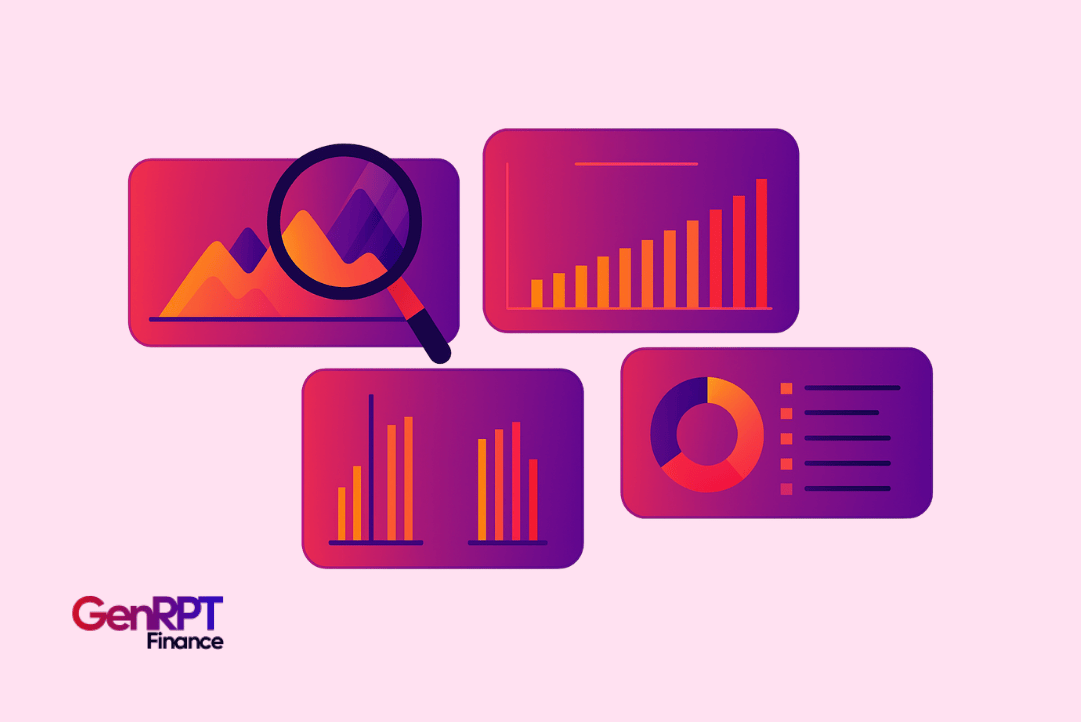
Market Risk vs Portfolio Risk: A Simple Comparison in Investment Research
October 21, 2025 By Yodaplus
In investment research, understanding different types of risk is essential for making sound financial decisions. Two of the most significant categories are market risk and portfolio risk. Both influence how investments behave under changing economic conditions, yet they affect decision-making in different ways.
For financial advisors, asset managers, portfolio managers, and wealth advisors, distinguishing between these risks is key to creating strategies that protect investments while pursuing growth. This guide by GenRPT Finance explains how each type of risk works, how they’re measured, and why both are vital to modern equity research.
What Is Market Risk?
Market risk refers to the chance that an investment’s value may decline due to changes in the overall market. It’s shaped by external forces such as interest rate shifts, inflation, currency fluctuations, and geopolitical events.
For example, during a global economic slowdown, even well-performing companies can see their stock prices fall because of a negative macroeconomic outlook.
Market risk analysis focuses on how sensitive investments are to these broad movements — a critical task for investment analysts and financial consultants aiming to guide clients through volatile conditions.
Key characteristics of market risk:
-
Driven by external factors beyond an investor’s control
-
Affects nearly all asset classes simultaneously
-
Measured through indicators like market volatility, beta, and interest rate trends
What Is Portfolio Risk?
Portfolio risk, on the other hand, measures the potential for loss within a specific group of investments. Unlike market risk, it’s shaped by the actual composition of the portfolio — the types of assets, sectors, and geographies chosen.
For instance, a portfolio made up solely of technology stocks will be more vulnerable to downturns in that industry. A diversified mix, however, spreads exposure and reduces sensitivity to a single sector’s performance.
Portfolio risk assessment considers correlations between assets and sector exposure to understand how one investment’s performance may impact overall results.
Portfolio risk can be managed through:
-
Diversification across asset classes, industries, and regions
-
Allocating investments based on individual risk tolerance
-
Using AI for data analysis and AI report generators for continuous monitoring and updates
Comparing Market Risk and Portfolio Risk
While market risk reflects external market-wide movements, portfolio risk reflects internal structure and diversification. Both are essential for equity research analysts, who must highlight how much of a portfolio’s performance depends on broad economic forces versus asset-level decisions.
In an equity research report, these comparisons help investors understand where exposure lies and how to adjust allocations for better risk control.
The Role of Investment Research in Managing Both Risks
Comprehensive investment research evaluates both market and portfolio risks together. A strong analyst report typically includes:
-
Company-specific financial reports
-
A macroeconomic outlook to evaluate market-wide trends
-
Equity analysis to assess performance and valuation
-
Data-driven insights from equity research automation tools like GenRPT Finance
This combined perspective enables financial data analysts and wealth managers to balance long-term growth objectives with prudent risk management.
Using Technology to Enhance Risk Analysis
Modern platforms like GenRPT Finance use AI-driven analytics to process massive datasets quickly and accurately.
Tools such as AI for equity research and AI report generators combine market indicators with real-time portfolio data to highlight emerging risks and opportunities. This ensures that risk assessment is not a one-time activity but an ongoing, automated process integrated into daily portfolio reviews.
Practical Example
Consider an investor with a diversified portfolio of stocks, bonds, and international assets:
-
Market risk might stem from a global recession affecting all markets.
-
Portfolio risk might arise from overexposure to one country’s bonds or industry.
In this scenario, market risk analysis would focus on global economic indicators, while portfolio risk assessment would evaluate internal asset allocation and concentration.
Why Both Matter for Long-Term Success
Focusing on one type of risk while ignoring the other leaves portfolios vulnerable.
-
Ignoring portfolio risk can lead to overconcentration in a single sector.
-
Ignoring market risk can blindside investors during systemic downturns.
For analysts preparing equity research reports, addressing both is essential. For financial advisors and wealth managers, this dual approach strengthens client confidence and drives sustainable results.
Conclusion
Market risk and portfolio risk are two sides of the same coin. Market risk assesses the bigger picture, while portfolio risk examines what’s inside the investment strategy.
By leveraging GenRPT Finance’s equity research automation, AI data analysis, and intelligent report generation, professionals can measure and manage both types of risk more effectively.
For asset managers, financial consultants, and portfolio managers, integrating these insights ensures that investment strategies remain balanced, transparent, and aligned with long-term client goals.
